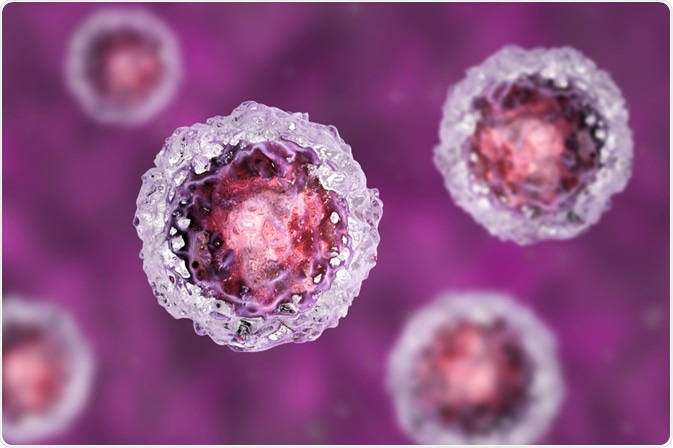Cancer cells are considered to be aberrant versions of their tissues of origin. However, their ability to proliferate and resistance to therapy led to the theory that cancers contain a heterogeneous population of cells. One theory that has gained traction since a hallmark paper was published in 2001 is the cancer stem cell (CSC) hypothesis.

Kateryna Kon | Shutterstock
The first assumption of the CSC hypothesis is that the cells in any given cancer mass are unequal, or heterogeneous. This describes a tumor in which cancer cells are hierarchically organized, and contain a small subpopulation of cancer stem cells (CSCs) that can proliferate extensively to sustain the progression and growth of the tumor.
The rationale behind this theory is that stem cells possess two properties, or hallmarks; (1) indefinite self-renewal and (2) pluripotency. The latter refers to the differentiation of the stem cell to become a specific cell type which is unipotent (can only produce daughter cells of the same type).
The second assumption of the CSC hypothesis is that CSCs are physically identifiable, possessing distinctive surface markers which differentiate them from other cancer cells.
Thirdly, the CSCs in a tumor comprises a mixture of cells which are either tumor-promoting (tumorigenic) or benign (non-tumorigenic). The tumorigenic population of CSCs is often considered to be tumor-initiating cells (TICs), aiding tumor relapse and resistance to therapy. For this reason, TICs are important therapeutic targets in drug development.
Evidence for CSCs
The most persuasive evidence for the existence of stem cells within a tumor comes from the analysis of cell surface markers. In 2003, Al-Hajj and colleagues identified that, in 8/9 primary breast tumor samples, the tumorigenic cells were CD44+/CD24-/low/ESA+/lin- i.e. positive for marker CD44, negative or low for CD24, positive for the marker Epithelial Specific Antigen (ESA), and negative for the lineage (lin) marker. This identified the breast cancer stem cells.
Singh et al. revealed that the tumorigenic brain cancer stem cell population was characterized by CD133+. These cells could produce new tumor colonies termed neurospheres and could be reproduced in human brain tumors when injected into mice. Similarly, human colorectal cancer cells possessed the same qualities of tumor colony initiation and tumor reproduction. This evidence, whilst robust, has been contested.
The Cancer Stem Cell Theory
Evidence Against CSCs?
The CSC hypothesis has been directly refuted by work that has demonstrated that tumors can grow rapidly; if CSCs existed, and were drivers of formation, they should be infrequent and identifiable by surface markers.
In 2007, Andreas Strasser found that a high proportion (1 in 10) of leukemia cells transplanted into mice could initiate lymphomas. Similarly, Sean Morrison found 25% of unselected melanoma cells (that is, without any surface marker) could form tumors in mice. These findings have been refuted since, with an increasing body of evidence pointing to the existence of CSCs possessing the qualities of infrequency, isolation by surface markers, the ability to form tumors following xenotransplantation.
Origins of CSCS: the connection between Epithelial-Mesenchymal Transition (EMT) and CSCs
The Epithelial-Mesenchymal Transition (EMT) is the process in which differentiated cells de-differentiate to acquire stem cell properties. Oncogenic mutations are posited to drive this process and promote self-renewal.
This mechanistic link is palpable, as it suggests that a large cell population could possess tumorigenic potential (as found by Strasser and Morrison), but only a small subset would initiate the tumor. The evidence for this comes from the work of Thomas Brabletz (2005) and Mani, which was published in Cell in 2008.
More specifically, factors that control gene expression called transcription factors, were found to be upregulated in CSCs. These transcription factors activated transcriptional programs that are seen in stem cells; the factors that are known to cause EMT, SNAIL and TWIST were identified.
Furthermore, extrinsic drivers of CSC production were found to promote the transcription of factors needed for the EMT. This was demonstrated by Scheel et al., who found that mammary cells underwent EMT by extrinsic signaling molecules TGF-β and Wnt.
The EMT program in mammary cells subsequently induced migration and sphere formation. In agreement, inhibition of extrinsic factors in transformed cells prevented tumorigenesis and metastatic spread. Thus, circulating tumor cells have features of both EMT and cancer stem cells and play a substantial role in resistance and metastasis.
Implications for current and emerging therapies
The notion that EMT induction leads to the formation of CSCs has been supported by research in more recent years and suggested that targeting the EMT process can represent a potential therapeutic target to treat cancer. Conventional chemotherapy primarily targets the numerous highly proliferative cells to reduce the tumor size, promoting the increased frequency of CSCs that arise through EMT.
This subsequently replenishes these lost cells, and tumor recurrence results. Direct target of CSCs, through interference with signaling pathways and transcription factors implicated in EMT, and thus CSC production - termed ablation - would prevent cancer stem cells from providing differentiated cells to populate the tumor mass.
Such inhibition of tumor regeneration would ultimately lead to the regression of the tumor. Efforts are currently underway and include blocking stem cell self-renewal pathways, targeting the microenvironment that sustains CSCs, inducing CSC programmed cell death, as well as forcing CSCs to differentiate into non-proliferative cell types amongst targeting the EMT pathway.
Last Updated: Dec 6, 2018